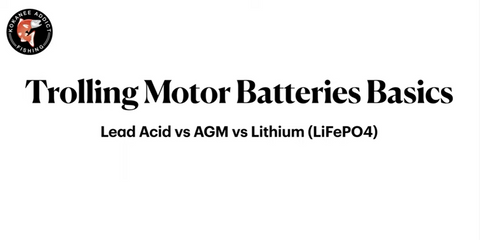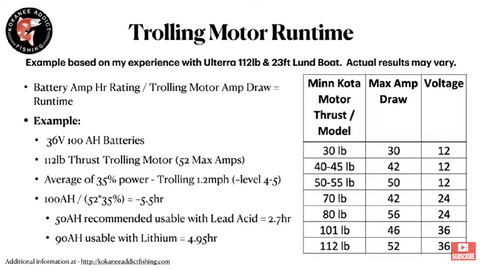Trolling Motor Batteries - Lead Acid vs AGM vs Lithium LiFePO4. Is Lithium Worth It?
Johnson primarily use electric trolling motor as main source of propulsion,so over about last 10 years Johnson gone through several different types of batteries.He decided to do some more research and find out what batteries are going to best for him.Next Johnson talked about lead acid agm and lithium batteries.

First of all Johnson talked about some of the comment terms.

So first Johnson talked about deep cycle lead acid batteries which made to be slowly drained and recharged unlike a starting battery that is used for quick bursts of power.A high quality lead acid could be used about 2-3 yrs if properly maintained.
Pros:
- lowest cost
Cons:
- requires maintenance-cells need to be topped off
- May leak or spill
- Subject to premature failure if discharged beyond 50% DOD
- Weight about 60 lbs for a group 31
- Limited 1yr warranty

The next type of battery is AGM battery.They are also Lead Acid but are completely sealed so they require no maintenance.we are going to get two to three years of use with a high quality battery.
Pros:
- mediun cost
- Sealed-no maintenance required not subject to spills
Cons:
- subject to premature failure if discharged beyond 50%DOD
- Weight about 60 lbs for a group 31
- Limited 1-1.5yr warranty

The next type of battery is lithium or lithium iron phosphate.LiFePO4 Batteries are the latest in battery technology.
Pros:
- 10 yr life 5-10 yr warranty’s available, 3-5000+ cycle count
- Weight savings-25lbs vs 70lbs
- Longer runtime-can be safely discharged to 90% DOD
- Sealed-no maintenance required not subject to spills
- BMS - battery management system,computer built into the battery
- Full voltage-due to the way LiFePO4 charges&capable of charging at higher AMPs
Cons:
- high initial cost
- Special requirements for charging in cold weather(below 32F)

On this chart earlier lithium batteries hold that same voltage over the whole length of their discharge cycle where lead acid drops. So the big pro with this is you are going to get full power the entire time with lithium with lead acid.

It can be seen from the figure the first reason Johnson use lithium is to be able to get that additional run time in the same footprint and have that long lasting battery.

Johnson has a 23 foot aluminum lund boat with the 112 thrust 36 volt trolling motor.In this system Johnson got those three batteries hooked together with 100 amp hours by the trolling motor amp draw.Johnson got a little chart on the right,he got the 36 volt 100 amp hour batteries with 112 pound thrust trolling motor. It’s around five to six hours with a full set of brand new batteries and goes about 1.2 miles an hour and level four to five on remote out of 10.

If you do want to go the lithium route ,a couple of things to keep in mind so all lithium batteries will have some type of battery management system.so you can step up to one that has bluetooth to monitor SOC very important if using Ulterra. Another thing to keep in mind the battery management system can also help with that cold weather charging protection. Another system out here that is actually has a heater built into the battery and if it’s below 32 degrees it’ll heat the battery first and then it will start charging.There’s also sealed or serviceable,serviceable batteries out there. One that’s sealed you just have to send back to the manufacturer versus as a serviceable .One if there’s a component may bms board went out it is possible for them to send parts .There he would look at the customer reviews and if have questions trying reaching out customer service.Do some research and then also make sure the batteries will work with either a parallel or series systems and the last thing is the warrant.

All the batteries on this list are good and Johnson ranked the different categories in the form.Finally Johnson chooses the ao lithium by contrast.It has the bluetooth bms so he can check the states of charge which is really important.It does have cold weather protection and if in the warranty period something breaks there’s a potential for it to be repaired without a complete replacement.It does have an eight year warranty and the cost as at the time of this was about six hundred dollars.Johnson actually had these batteries just got them installed on his boat and he also plans on doing a couple follow-up videos to show how they’re working.







Leave a comment